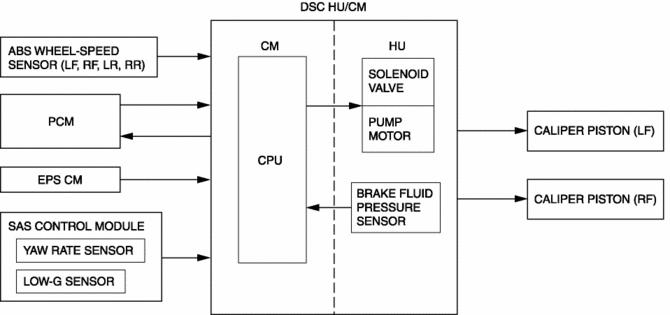Mazda CX-5 Service & Repair Manual: Tcs Control
Outline
-
The TCS control actuates torque reduction through engine control, as well as using brake control to control traction.
NOTE:
-
Engine control: Engine output is lowered by fuel cut and ignition timing control to reduce the traction, preventing driving wheel slip.
-
Brake control: Brake fluid pressure from the hydraulic unit (HU) to the driving wheel that is slipping is increased, operating the brake and preventing driving wheel slip.
Features
-
The left and right wheels are controlled at the same time by engine control. Therefore, when the road surface friction coefficients differ between the left and right wheels, proper torque reduction cannot be performed separately for each wheel. When this occurs, torque reduction is performed by independent left and right wheel brake control, providing more stable vehicle control.
-
The TCS OFF switch allows the driver to optionally enable/disable the TCS control at the driver's discretion.
-
When both driving wheels are stuck, traction control according to the driver's operation can be performed by inhibiting the TCS control.
-
The TCS control returns to normal operation automatically at the next ignition cycle.
Construction
Block Diagram

Operation
-
TCS control detects driving wheel spin based on the signals listed below, sends torque reduction request signals to the PCM, and also controls the solenoid valves and pump motor in the DSC HU/CM.
-
Vehicle wheel speed signals from the font and rear ABS wheel-speed sensors
-
Engine torque signal from the PCM
-
Steering angle signal from the EPS CM
-
Yaw rate and lateral-G signals from the SAS control module
-
Fluid pressure signal from the brake fluid pressure sensor (built into the DSC HU/CM)
 Precaution [Dynamic Stability Control (DSC)]
Precaution [Dynamic Stability Control (DSC)]
1. The ABS warning light and/or brake system warning light and/or TCS/DSC indicator
light and/or TCS OFF indicator light illuminate even when the system is normal.
Warning ...
 Tcs Off Switch Inspection
Tcs Off Switch Inspection
1. Remove the TCS OFF switch..
2. Verify that the resistance between the TCS OFF switch terminals B and C is
as indicated in the table.
If not as indicated in the table, replace the TCS OF ...
Other materials:
Front Fender Junction Installation [Panel Replacement]
Symbol Mark
Installation Procedure
1. When installing new parts, measure and adjust the body as necessary to conform
with standard dimensions.
2. Drill holes for the plug welding before installing the new parts.
3. After temporarily installing new parts, make sure the related parts fit p ...
Filament Inspection
1. Switch the ignition ON (engine off).
2. Turn the rear window defroster switch on.
CAUTION:
Directly touching the rear window defroster filament with the lead of the
tester could damage it. Wrap aluminum foil around the end of the lead and inspect
the filament by touching it ...
Transmission/Transaxle Abbreviations
AAS
Active Adaptive Shift
ABS
Antilock Brake System
ABDC
After Bottom Dead Center
ACC
Accessories
AFS
Adaptive Front Lighting System
ALC
...
